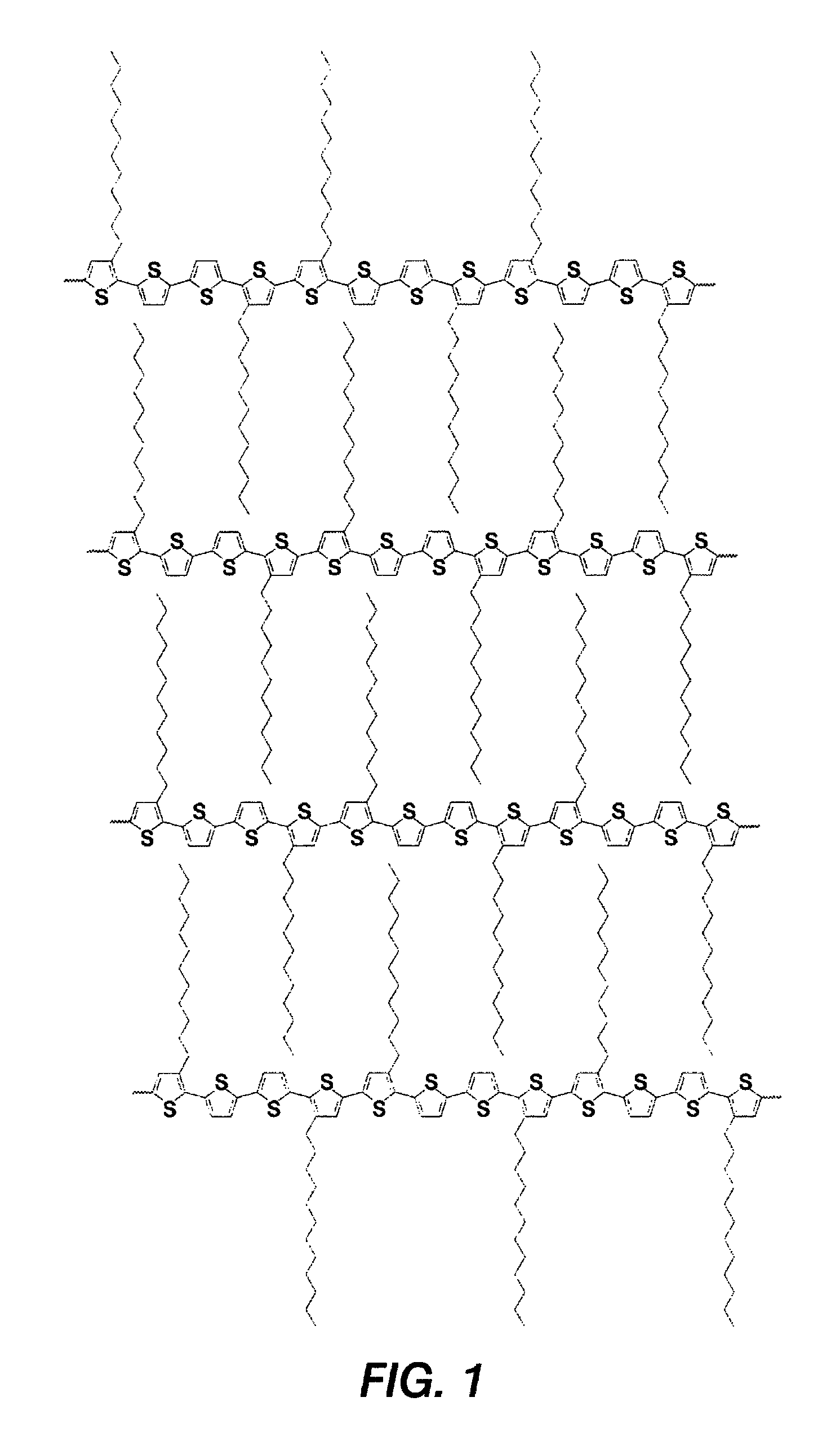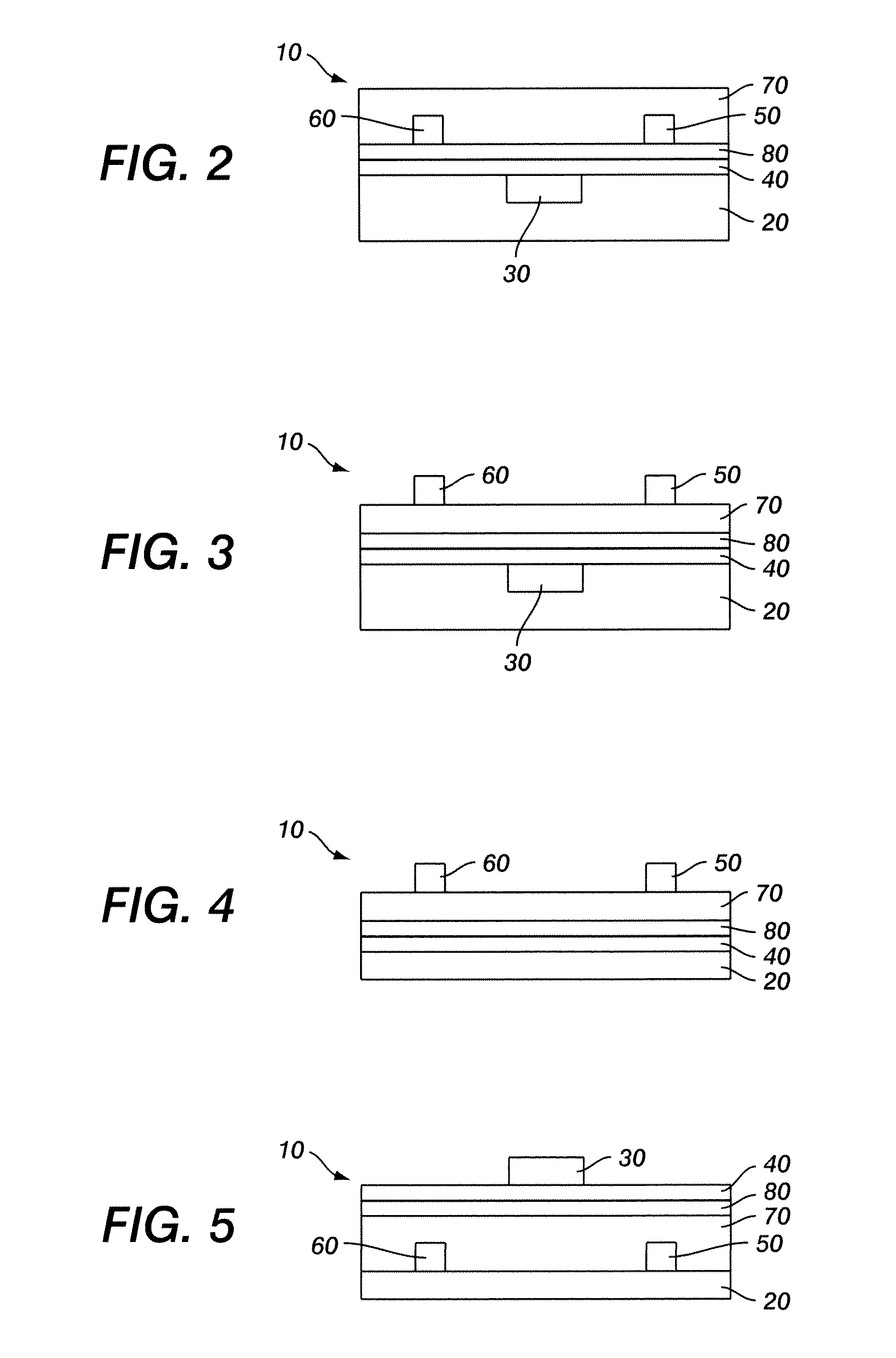Polythiophenes and electronic devices comprising the same
a technology of polythiophene and electronic devices, applied in the direction of non-metal conductors, conductors, organic conductors, etc., can solve the problems of high silicon-based tft circuit costs, high cost of silicon-based tft circuits, and high cost of high-performance organic semiconductors. to achieve the effect of eliminating chlorinated solvents
- Summary
- Abstract
- Description
- Claims
- Application Information
AI Technical Summary
Benefits of technology
Problems solved by technology
Method used
Image
Examples
example 1
[0070]Poly[5,5′-bis(3-dodecyl-2-thienyl)-3-methyl-2,2′-dithiophene] was prepared as described in Scheme 1. This polythiophene corresponds to Polythiophene 1 of Scheme 1 set forth above.
[0071]Preparation of Monomer:
[0072]A solution of 2-bromo-3-dodecylthiophene (15.36 grams, 46.36 mmol) in 30 milliliters of anhydrous tetrahydrofuran (THF) was added slowly over a period of 20 minutes to a magnetically stirred suspension of magnesium turnings (1.69 grams, 69.52 mmol) in 10 milliliters of THF in a 250 milliliter round-bottomed flask under an inert argon atmosphere. The resultant mixture was stirred at room temperature for 2.5 hours, and then at 50° C. for 30 minutes before cooling down to room temperature.
[0073]The resulting fresh prepared Grignard reagent, 3-dodecyl-2-thiophenemagnesium bromide, was then added via a cannula to a mixture of 5,5′-dibromo-3-methyl-2,2′-dithiophene (6.27 grams, 18.54 mmol) and Ni(dppe)Cl2 (0.48 gram, 0.91 mmol) in 50 milliliters of anhydrous THF in a 250 m...
example 2
[0077]Three copolythiophenes were prepared according to Scheme 2 as set forth above. Monomer 2 was prepared by the method described in U.S. Pat. No. 6,770,904. Monomer 1 was prepared by the method described in Example 1.
[0078]For Copolythiophene 2a, x=90 mole % and y=10 mole %.
[0079]For Copolythiophene 2b, x=80 mole % and y=20 mole %.
[0080]For Copolythiophene 2c, x=50 mole % and y=50 mole %.
[0081]For Copolythiophene 2a, a solution of mixed 5,5′-bis(3-dodecyl-2-thienyl)-2,2′-dithiophene (Monomer 2) (500 mg, 0.75 mmol) and 5,5′-bis(3-dodecyl-2-thienyl)-3-methyl-2,2′-dithiophene (Monomer 1) (57 mg, 0.084 mmol) in 10 milliliters of chlorobenzene was added slowly over a period of about 5 minutes to a well stirred mixture of FeCl3 (500 mg, 3.08 mmol) in 5 milliliters of chlorobenzene in a 100 milliliter round-bottomed flask in an inert argon atmosphere. This mixture was stired at 60° C. for 48 hours. After the polymerization, the mixture was diluted with 50 milliliters of methylene chlori...
PUM
| Property | Measurement | Unit |
|---|---|---|
| thick | aaaaa | aaaaa |
| thick | aaaaa | aaaaa |
| thickness | aaaaa | aaaaa |
Abstract
Description
Claims
Application Information
 Login to View More
Login to View More - R&D
- Intellectual Property
- Life Sciences
- Materials
- Tech Scout
- Unparalleled Data Quality
- Higher Quality Content
- 60% Fewer Hallucinations
Browse by: Latest US Patents, China's latest patents, Technical Efficacy Thesaurus, Application Domain, Technology Topic, Popular Technical Reports.
© 2025 PatSnap. All rights reserved.Legal|Privacy policy|Modern Slavery Act Transparency Statement|Sitemap|About US| Contact US: help@patsnap.com



